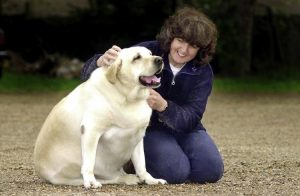How To Help My Dog Lose Weight
At our dog training facility in Northern Virginia, we always get asked questions about how they can manage their dog’s weight.
I am always quick to point out the fact that I am not a veterinarian, and you should seek guidance from them; however, there are easy/general changes you can make to your dog’s diet to begin seeing results.
I will start with the very simple concept and principle that dogs get overweight for the same reasons that people do: overeating and under exercising. It’s important to point out that there is an estimate that roughly 35-40 million dogs in the US are considered obese or overweight. This is the number one nutrition related problems in dogs throughout the United States.
How To Tell If Your Dog Is Overweight?
1. Rib Test: Run your hand down the sides of your dog. If you cannot feel their ribs, they are overweight.
2. No Tuck of the Abdomen: You should see your dog’s abdomen tuck up from the underneath (once it gets passed their chest area).
3. When looking from an overhead view of your dog, you should see their sides indent in (making a waist). If should not be just broad and wide from their head to the rear-end.
How To Weigh My Dog?
1. Take them to the Vet.
2. If you have a smaller dog, one easy method is for your to stand on a scale and capture your weight. Now, pick your dog up, stand on the scale, and capture that weight. Now simply subtract you and your dog’s combined weight from your weight, now you have your dog’s weight.
Once you have your dog’s weight, you can compare it to a reputable breed website, to see what the standard is for your breed: http://www.petobesityprevention.com/ideal-weight-ranges/.
How To Start Helping My Dog Lose Weight?
1. Use a measuring cup, so you can see “exactly” how much food your dog is getting per day. Do not just “guesstimate.”
2. See how much food is recommended for a dog the size of yours, and compare that to how much you have been giving them. Like a person, slowly reduce their portion sizes.
3. Do not “free-feed.” Your dog should not have 24/7 access to food. You should feed them 2-3 times per day.
4. Increase activity in your dog. Take them on walks, runs, throw the ball, play tug with them, do scent detection, or some other type of sport. As your dog is doing better, slowly increase the speed and the duration of the activities. This helps keep them mentally and physically stimulated, promotes weight loss, and speeds up their metabolism.
5. Cut out the treats and unnecessary snacks! Just like with a person on a diet, it’s not okay to have ice cream or twinkies on a daily basis, even if in minimal amounts. Small amounts on a daily basis adds up to be a lot of calories.
Monitor Your Dog’s Progress Weekly:
Every week, weigh them and monitor their progress. This will help you decide if you need to increase or decrease their caloric intake.
At our dog training facility in Northern Virginia on a daily basis we hear, “I don’t know why is overweight, we go on walks daily.”
Remember, dogs are just like people, one of my good friends Dave Shulter who owns Shutler Fitness always says, “Abs are made in the kitchen, not in the gym. You can workout every day of your life, but if you do not change your diet, you will never major see results.” The same is true for your dog.
www.offleashk9training.com
www.facebook.com/offleashk9
www.youtube.com/offleashk9training

